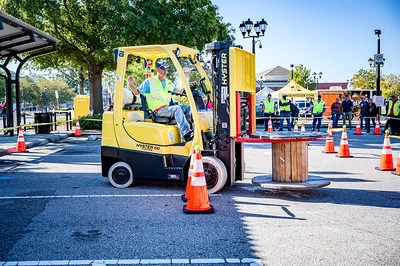How to Get a Forklift License in Arizona (2024)
May 9, 2024 | by onlineoshasafetytraining.com


If you’re looking to drive a forklift in Arizona, you’ll need to get a special license for it. Even though you don’t need your regular driver’s license, driving a forklift requires you to learn specific skills and safety rules.
This is because operating a forklift is quite different from driving a car, and it’s important to know how to handle one safely in the workplace. In this state, you have to complete a training program and pass a test to get your forklift certification.
This guide will walk you through what you need to know to get started and legally operate a forklift.
Let’s Discuss First the Eligibility Requirements
To qualify for a forklift license, there are a few basic requirements you need to meet:
- Age Requirement
- In Arizona, you need to be at least 18 years old to operate a forklift. This age limit is set to ensure that forklift operators have the maturity and responsibility necessary to handle such heavy and potentially dangerous equipment safely.
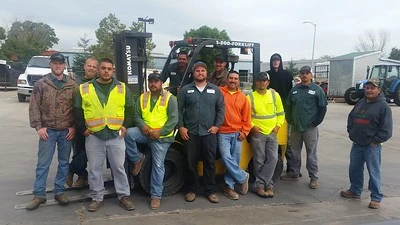
- Physical Requirements
- Physical fitness is crucial for forklift operators because they need to be able to manage the physical activities associated with operating the machinery. This includes:
- Vision: Good vision is necessary for safety. Operators must be able to see clearly, whether that’s naturally or with corrective lenses, to navigate the workplace, spot hazards, and manage loads accurately.
- Hearing: Being able to hear warnings, signals, and instructions in a potentially noisy environment is essential for safe operation.
- Physical Strength and Agility: Operating a forklift often involves maneuvering in tight spaces, adjusting controls, and sometimes manually handling loads. Operators should have the physical ability to perform these tasks without difficulty.
- Physical fitness is crucial for forklift operators because they need to be able to manage the physical activities associated with operating the machinery. This includes:
- Education
- Forklift operators don’t need a specific level of formal education like a high school diploma, but they must be able to read, write, and understand English well enough to comprehend training materials and safety protocols. This requirement ensures that all operators can follow safety instructions and legal regulations, and are capable of understanding hazard communications and operational procedures.
- State-Specific Requirements
- In addition to the general requirements, Arizona mandates that all forklift operators complete a training program certified by OSHA. This training includes:
- Classroom Learning: Covers the theoretical aspects of forklift operation, including safety rules, proper handling techniques, and understanding the different parts of a forklift.
- Practical Training: Provides hands-on experience in operating a forklift under the supervision of a qualified trainer.
- Evaluation: After the training, operators must pass both a written test and a practical driving test to demonstrate their knowledge and skills in operating a forklift safely.
- In addition to the general requirements, Arizona mandates that all forklift operators complete a training program certified by OSHA. This training includes:
The Forklift Training Programs You Can Opt Into
There are several types of training programs available for those looking to obtain a forklift license. Each type caters to different learning styles and logistical needs:
- Online Training
- Description: These programs provide the theoretical part of forklift training via online platforms, which is convenient for those who may not be able to attend in-person classes due to time or distance constraints.
- Content: Includes safety regulations, understanding of forklift operations, and warehouse safety protocols.
- Duration: Typically, online courses can be completed at the student’s own pace, but usually take a few hours to complete the theory part.
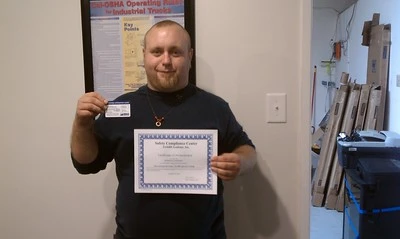
- In-Person Training
- Description: This is the most comprehensive form of training, involving both classroom instruction and hands-on practice under the supervision of qualified trainers.
- Content: In addition to the theoretical knowledge covered in online courses, in-person training includes practical, hands-on instruction in operating a forklift, navigating through typical warehouse layouts, and performing actual load handling.
- Duration: These courses generally take longer, ranging from one day to a week, depending on the depth of training and the operator’s experience level.
- On-the-Job Training
- Description: Some employers provide direct training on the job, which is tailored to the specific needs of the workplace and the equipment used.
- Content: This training often includes a mix of formal instruction and practical experience, focusing on the specific types of forklifts used by the employer and the particular safety practices of the workplace.
- Duration: The length can vary based on the complexity of the equipment and the skills of the trainee but usually integrates into the employee’s initial work period.
Typical Content of Forklift Training Courses:
- Safety Procedures: Fundamental safety rules, such as how to perform safety checks on the equipment, understanding the stability triangle, and how to handle loads safely.
- Operations: Instructions on operating the controls, steering, and maneuvering, as well as how to start and shut down the forklift.
- Maintenance Basics: Basic maintenance and troubleshooting practices to ensure the machine operates safely and efficiently.
- Warehouse Navigation: Techniques for safely navigating in crowded and tight spaces typically found in warehouses.
- Emergency Procedures: Training on what to do in case of an accident or mechanical failure.
How To Get Forklift Certified (Step-By-Step)
To get certified as a forklift operator in Arizona, you need to follow a structured process that ensures you meet both theoretical and practical competency standards. Here’s a step-by-step guide on how to achieve certification:
Step 1: Choose a Training Program
- Research and Select: Look for a reputable forklift training program. Options may include online, in-person, or on-the-job training. Choose one that fits your learning style, schedule, and budget.
- Enroll: Once you’ve selected a program, enroll and register for the next available session. You may need to provide basic personal information and possibly some proof of age or physical ability.
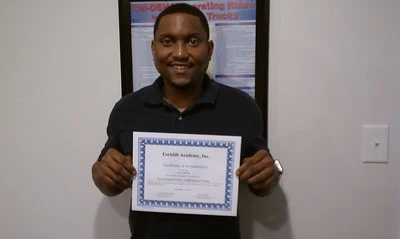
Step 2: Complete Theoretical Training
- Classroom or Online Learning: Participate in the theoretical component, which can be conducted in a classroom setting or online. This part covers:
- Forklift Types: Different types and their specific operations.
- Safety Standards: OSHA regulations, safety protocols, and hazard identification.
- Legal Responsibilities: Operator’s legal responsibilities and workplace safety laws.
Step 3: Undertake Practical Training
- Hands-On Experience: Engage in hands-on training under the guidance of a certified instructor. This training typically takes place on actual forklifts, allowing you to apply what you’ve learned in a controlled and supervised environment.
- Skill Development: Practice basic maneuvers such as steering, lifting, stacking, and unloading, as well as more complex skills tailored to specific workplace scenarios.
Step 4: Pass the Certification Exam
- Written Test: After completing your theoretical training, you’ll take a written exam that tests your knowledge of forklift operations and safety procedures.
- Practical Test: Demonstrate your forklift operating skills in a practical test. This might involve various tasks, such as moving and stacking loads, navigating through obstacle courses, and performing routine safety checks.
Step 5: Obtain Your Certification
- Receive Certification: Upon successfully passing both tests, you will be issued a forklift operator certification. This certification is proof that you have met the required standards of knowledge and skill to operate forklifts safely.
- Validity: Typically, forklift certifications are valid for three years. After this period, recertification is necessary, which may require additional training and testing, especially if there have been any violations or accidents, or if new regulations have come into effect.
Components of the Training
- Theoretical Component: This includes learning all relevant laws, safety protocols, and the operational characteristics of different forklift types. It provides a solid knowledge base that ensures you understand the risks and responsibilities of operating a forklift.
- Practical Component: This part of the training puts theory into practice. It’s essential for developing real-world skills and confidence in operating a forklift. The practical training covers everything from basic handling to complex operations specific to particular work environments.
By following these steps and successfully completing both the theoretical and practical components of the training, you will be well-prepared to safely operate a forklift and adhere to workplace safety standards.
Here are Tips to Pass the Certification Exam
The written test focuses on the theoretical knowledge necessary for safe forklift operation. This includes understanding the different types of forklifts, their parts, and their functions, as well as mastery of safety regulations as dictated by OSHA and other relevant safety standards. It covers how to identify hazards in the workplace, proper load handling techniques, and the legal aspects of forklift operation. The questions can be in various formats, including multiple-choice, true/false, and fill-in-the-blank, designed to assess your knowledge comprehensively.
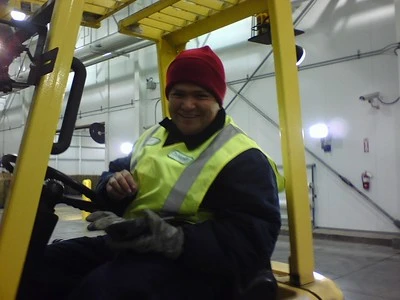
The practical test is about demonstrating your ability to operate a forklift safely and effectively. This part of the exam typically requires you to perform specific tasks under the observation of a qualified examiner. Tasks might include operating the forklift through a designated course, safely picking up and moving loads, stacking items at various heights, and performing routine pre-operation checks. The practical test not only evaluates your ability to drive a forklift but also how well you apply safety procedures during operation, such as checking for obstacles, properly navigating through tight spaces, and safely loading and unloading materials.
Preparing for the exam involves a combination of studying and practical practice. To prepare for the written test, review all the materials provided during the theoretical portion of your training. Focus on understanding safety protocols, operational procedures, and legal regulations rather than memorizing them superficially. Many training programs provide sample questions or practice tests, which can be incredibly helpful. Going over these practice materials multiple times can significantly boost your confidence and help solidify your knowledge.
For the practical test, the best preparation is hands-on practice. Spend as much time as you can operating the forklift in a safe training environment under the supervision of a qualified instructor. Practice the maneuvers and tasks you’ll be tested on, such as lifting, stacking, and navigating. Pay particular attention to your instructor’s feedback during these practice sessions and work on any weaknesses identified.
If You’re Looking for A Training Provider, Here are Your Choices
| Provider Name | Location(s) | Types of Training Offered | Contact Information |
|---|---|---|---|
| Raymond West Inc | Phoenix, AZ | Comprehensive forklift operator training including basic and advanced courses. | Phone: (602) 275-2228 |
| ROI Safety Services | Phoenix, AZ | On-site training for individuals and groups, covering forklift safety and operation. | Phone: Not available online |
| ForkliftTraining.com | Statewide (Online) | Online courses that are OSHA-compliant, covering all classes of powered industrial trucks. | Website |
| Naumann/Hobbs | Phoenix and Tucson, AZ | OSHA certified courses, train-the-trainer programs, and workplace safety classes. | Phoenix: (602) 437-1331, Tucson: (520) 623-5865 |
| Arizona Lift Training | Phoenix, AZ | Specializes in a range of equipment safety training including warehouse forklift safety and heavy equipment operation. | Phone: Not available online |
How Much Does The Forklift License Cost
Obtaining a forklift license in Arizona involves various costs, which generally include fees for training courses, examination, and certification. Here’s an overview of these expenses:
Training Course Fees
The cost of forklift training courses can vary significantly based on the type of training chosen and the training provider.
- Online Training: This is often the most cost-effective option, with prices ranging from $50 to $200. These courses are typically less expensive because they don’t require physical equipment or in-person instructor time.
- In-Person Training: In-person courses, which provide comprehensive theoretical and practical training, tend to be more costly. Prices can range from $150 to $600, depending on the depth of the training and the reputation of the training center.
- On-the-Job Training: Costs for on-the-job training can vary widely. Some employers may cover the full cost of training for their employees, while others might deduct training fees from the employee’s wages or require the employee to pay upfront. The direct cost to the employee can range from minimal to several hundred dollars, similar to in-person training fees.
Examination Fees
- Most training courses include the examination fee as part of the overall training cost. However, if the exam is taken separately or if a retest is required, you might expect to pay an additional fee. This fee can range from $50 to $100 per exam attempt.
Certification Fees
- After successfully passing the exam, there may be a fee for issuing the certification card. This fee varies but generally ranges from $25 to $50. This certification card is what you will need to show to employers as proof of your qualification to operate a forklift.
Additional Costs
- There might be additional costs associated with training materials, such as textbooks or online resources, particularly if these are not included in the course fee. These costs are usually minimal, ranging from $20 to $50.
- Travel and accommodation expenses may also need to be considered if the training center is not local, which could significantly increase the total cost.
Recertification Costs
- Forklift operators must typically recertify every three years, which may involve taking a refresher course and passing another exam. The costs for recertification can be similar to the initial certification, depending on the extent of the refresher training required.
Do You Have an Expired Forklift License
if you operate a forklift, you need to renew your license every three years. Here’s how the renewal process works and why it’s important:
How to Renew Your Forklift License
- Check Your Skills and Knowledge:
- Before your license can be renewed, someone might check how well you can still operate a forklift and your knowledge of safety rules. This helps to see if you need a quick refresher course.
- Take a Refresher Course:
- If the assessment shows you need to brush up on certain skills or the latest safety rules, you’ll take a short course. This course helps you get up to date with new forklift technology, any changes in safety laws, or different ways of doing things at work.
- Pass the Test Again:
- After your refresher course, you need to pass the certification test again to prove you’ve still got the skills and knowledge to safely operate a forklift.
- Get Your New License:
- Once you pass the test, you’ll get a new license that’s good for another three years.
Why Keeping Your Certification Up to Date is Important
- Stay Safe: Forklifts can be dangerous if not used correctly. Regular training and testing make sure you keep following safety rules, which helps prevent accidents.
- Follow the Rules: The law requires forklift drivers to be certified. By renewing your license, you follow these laws, and your workplace avoids getting into trouble.
- Keep Your Skills Sharp: Technology and ways of working can change. Renewing your license means you get trained in these new areas, helping you work better and safer.
- Deal with Changes: Sometimes, the rules or your workplace might change. Renewing your license means you learn about these changes and how to handle them.
- Boost Your Career: Keeping your license updated can lead to better job opportunities and possibly more money. It shows you’re serious about your job and know how to keep things safe.
Renewing your forklift license isn’t just a rule to follow; it’s a good way to make sure you remain good at your job, stay safe, and keep up with any new changes in your work area.
Do You Need a Driver’s License to Drive a Forklift in Arizona?
No, you don’t need a regular driver’s license to drive a forklift in Arizona. However, you do need to get a specific forklift certification to operate one safely at work.
While you don’t need a regular driver’s license to operate a forklift, state law requires you to complete a certified forklift operator training program. This law follows the guidelines set by the Occupational Safety and Health Administration (OSHA), which applies across the United States.
Here’s a breakdown of the process:
- Forklift Training: You must undergo a training program that includes both classroom learning and hands-on practice. The training will cover topics like operating the forklift, safety practices, and how to handle loads.
- Certification Exam: After completing the training, you’ll need to pass an exam that tests both your knowledge and your ability to operate the forklift safely.
- Certification Card: Once you pass the exam, you’ll receive a forklift certification card. This card proves that you’ve been trained and are qualified to operate a forklift. It’s important to keep this card with you whenever you’re operating a forklift.
- Recertification: The certification isn’t forever. OSHA requires forklift operators to recertify every three years, or sooner if you are involved in an accident, operate the forklift unsafely, or have a change in your workplace that affects safety.
These steps are designed to ensure that all forklift operators know how to handle these vehicles safely to prevent accidents and injuries in the workplace. It’s crucial to follow these regulations closely to maintain a safe working environment.
Forklift Operator Salary in Arizona
As of April 24, 2024, the typical salary for a forklift driver in Arizona averages around $41,102. However, salaries can range from $36,902 to $46,502. This variation in pay can depend significantly on factors such as the specific city you work in, your educational background, additional skills you might have, and how long you’ve been in the field.
To get a job as a forklift operator in Arizona, follow these steps:
- Get Certified: Complete a forklift certification course that meets OSHA requirements. Online and in-person options are available.
- Seek Job Opportunities: Search job listings on platforms like Indeed, ZipRecruiter, and Glassdoor. Look for roles that match your skills and preferred location.
- Prepare Your Application: Tailor your resume to highlight your certification and any relevant experience. Mention specific equipment you’re trained on if applicable.
- Apply for Jobs: Apply to multiple positions to increase your chances. Include any additional skills or certifications that may be relevant.
- Attend Interviews: Be prepared to discuss your training and how you handle workplace safety.
Arizona has a steady demand for forklift operators, especially given its role as a logistics hub, so there are often many opportunities available.
To Make a Conclusion
Obtaining a forklift license in Arizona involves completing a certified training program that covers both practical and theoretical aspects of forklift operation. After training, you’ll need to pass a certification exam, which includes both written and practical tests. Once certified, you can safely operate a forklift in various work environments across the state, enhancing your job prospects in industries reliant on skilled operators. This certification not only boosts your employment potential but also ensures adherence to safety standards critical in operational settings.
RELATED POSTS
View all
